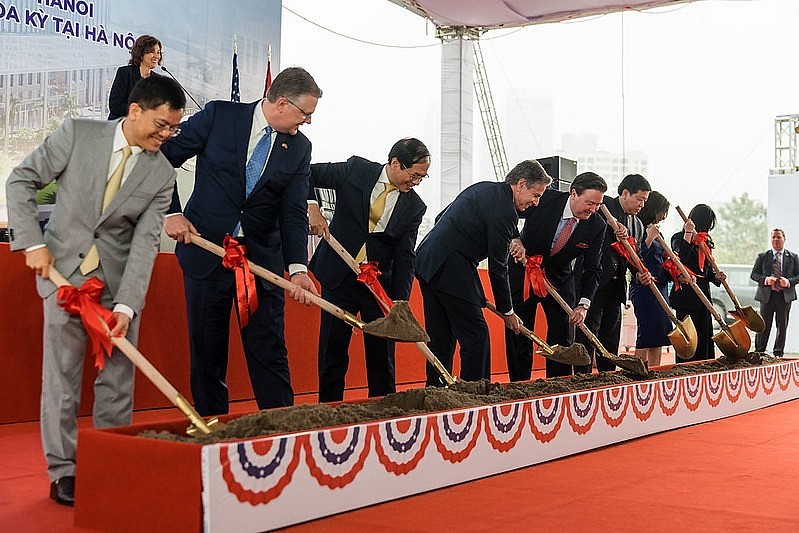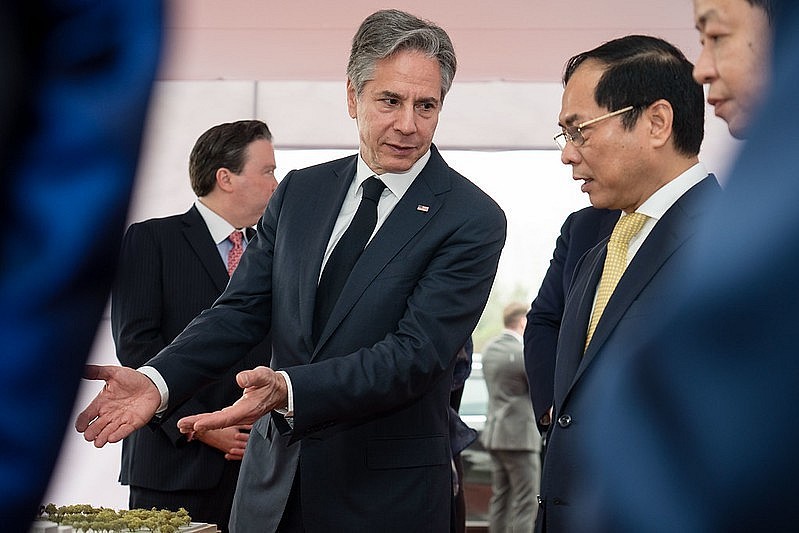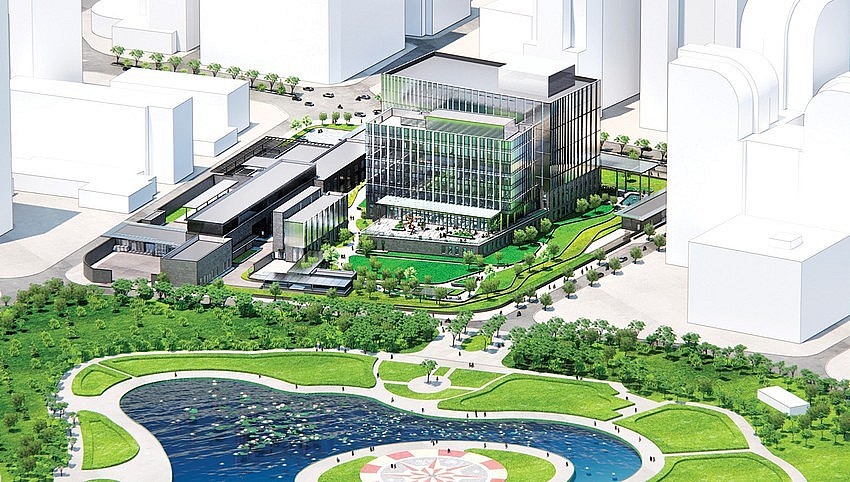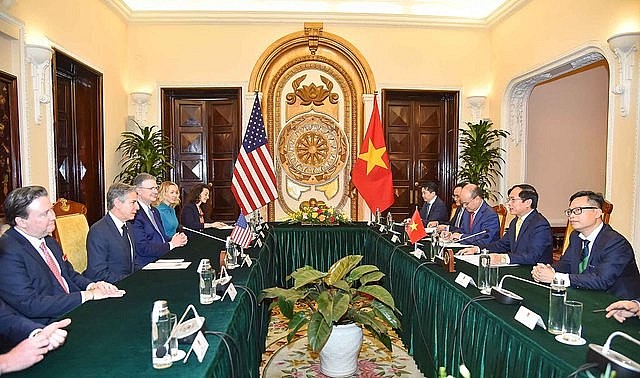 |
| A groundbreaking ceremony is held for new US Embassy in Hanoi. Photo: US Embassy |
“The new embassy represents ‘another significant step towards strengthening the vital partnership between our nations and peoples,’ US State Secretary Blinken declared in his address.”
The US Embassy campus boasts an impressive $1.2 billion total investment, constructed on 39,000 sq. m of land spanning 3.2 hectares. Surrounded by lush greenery, the embassy is truly a sight to behold, as reported by VietnamPlus.
The design concept will create a green, sustainable environment that reflects the US commitment to environmental stewardship and celebrates the cultural exchange between the two nations. The complex will include a variety of buildings, including a new embassy, a consular section, and a variety of support facilities. The design will feature a contemporary style that incorporates elements of traditional Vietnamese architecture, such as the use of wood, stone, and metal details. Additionally, the use of green roofing, solar panels, and energy-efficient lighting will ensure the complex is sustainable and efficient. The design will also include public spaces, such as a garden, courtyard, and pedestrian plaza, which will provide a welcoming environment for visitors and staff. The complex will be a symbol of the strong ties between the United States and Vietnam, and will represent the shared commitment of the two nations to the environment and to the cultural exchange between them.
The walls of the embassy will be constructed with recycled clay bricks, and the roof will be made of recycled steel sheets. The building will be equipped with solar panels and energy-efficient windows to reduce the strain on the national energy grid. Moreover, the building will have a rainwater harvesting system to ensure a continuous water supply during flood season.
Most of the construction for the new embassy will be done using recycled materials, making it an energy-efficient and flood-resistant structure. The foundation will be built with basalt stone, which is abundant both in Vietnam and the United States. The walls will be constructed with recycled clay bricks, and the roof will be made of recycled steel sheets. To further reduce stress on the national energy grid, the building will be equipped with solar panels and energy-efficient windows. Additionally, the embassy will feature a rainwater harvesting system, allowing it to remain operational during times of flooding.
 |
| Vietnamese Minister of Foreign Affairs Bui Thanh Son (R) and United States Secretary of State Antony Blinken. Photo: US Embassy |
The architecture of the campus will embody the shared commitments of the two countries in sustainability and climate change adaptation.
Blinken declared that this was the day he had been eagerly anticipating for a long time, noting that he had first come across this project when he was still serving as Deputy Secretary of State.
He expressed his deep gratitude to the Vietnamese Government and the US Embassy’s staff for their tireless efforts to make this historic day a stunning reality.
Over the past 27 years, since the normalization of ties in 1995, the relationship between Vietnam and the US has been steadily strengthened. This year marks the 10th anniversary of the Comprehensive Partnership between the two countries. The two countries have collaborated in all aspects, from enhancing public health to broadening all-encompassing economic opportunities to accelerating the transition to clean energy, Blinken noted.
The new embassy building will be eight stories tall and large enough to accommodate all personnel, according to the US diplomat.
 |
| The new embassy building will be eight stories tall and large enough to accommodate all personnel. Photo: EYP |
The embassy will also be able to significantly increase the number of consular service windows, allowing for more efficient and faster processing of visas and passports for a larger number of people, he noted.
It is estimated that the construction of this project will span a period of six years and provide employment to approximately 1,800 local workers. Furthermore, an additional $350 million will be added to the Vietnamese economy as a result. This will be a significant boost to the local economy and will provide numerous opportunities for the people of Vietnam.
At the event, Duong Duc Tuan, the Vice Chairman of the Hanoi People’s Committee, remarked that the project was the product of numerous years of hard work from both countries and the involvement of multiple agencies.
among employees is essential for the success of any organization. Cooperation among employees enables them to work together in order to achieve the desired goals. It helps in forming a healthy and productive work environment, which leads to better performance. When employees work together, it helps to foster creativity and innovation, as well as increase efficiency. It also helps to reduce conflicts and build a team spirit. In order to maintain cooperation among employees, it is important to create a culture of trust and respect. This can be achieved by providing clear communication and expectations, as well as providing recognition and rewards for positive performance. Additionally, it is important to foster a sense of team spirit and camaraderie among employees. This can be done by providing opportunities for socializing, team-building activities, and celebrating successes. By taking these steps, organizations can ensure that their employees are working together to achieve their goals.
During his stay in Vietnam, U.S. Secretary of State Antony Blinken held talks with Vietnam’s Minister of Foreign Affairs Bui Thanh Son, during which they shared the view that Vietnam and the United States should continue with their cooperation and promote the bilateral ties on the basis of the principles agreed by their respective high-ranking leaders, according to Nhan dan (People) newspaper.
They reviewed positive developments in the Vietnam-US comprehensive partnership over the past time, with two-way trade growing impressively, hitting $123 billion last year.
 |
| At the talks between Minister of Foreign Affairs Bui Thanh Son and US Secretary of State Antony Blinken. Photo: VGP |
Both highlighted the importance of collaboration in the fight against Covid-19, as well as the effectiveness of cooperation projects in addressing the legacies of war, particularly the dioxin remediation project at Bien Hoa Airport, and the growing number of Vietnamese students studying in the United States.
Vietnam always considers the US a key strategic partner and wishes to strengthen the comprehensive partnership on the basis of mutual benefits, and mutual respect for independence, sovereignty, territorial integrity and political institutions of each other, Son said.
He lauded the coordination between the Vietnamese Ministry of Foreign Affairs and the US Department of State over the past time, emphasizing Blinken’s role in promoting the bilateral ties, including the recent phone talks between Party General Secretary Nguyen Phu Trong and President Joe Biden, contributing to consolidating trust, creating more momentum, and opening a new period for cooperation between the two countries.
The FM suggested that the two sides step up all-level delegation exchanges and contacts this year, which marks the 10th anniversary of the comprehensive partnership, in order to deepen the bilateral relations for mutual benefits and for the promotion of peace, stability, cooperation, and development in the region and the world at large.
Blinken, for his part, affirmed the importance the US attaches to the friendship and comprehensive cooperation with Vietnam and commended Vietnam’s dynamic development, role and position in the region.
He emphasized the United States’ dedication to honoring political institutions, autonomy, sovereignty, and territorial integrity of Vietnam, and backing a robust, independent, self-sufficient, and thriving Vietnam.
The US will allocate additional resources and funds to help Vietnam address the aftermath of war, and strengthen bilateral cooperation in key areas such as trade and investment, science and technology, digital transformation, green transition, and high-quality personnel training to support the country’s development, he noted.
The two sides exchanged views on regional and international issues of shared concern.
Regarding the South China Sea (Bien Dong) issue, they agreed on the importance of peace, security, stability, and freedom of navigation and aviation in the waters. They emphasized the need to address disputes through peaceful measures in line with international law, including the 1982 United Nations Convention on the Law of the Sea (1982 UNCLOS). They further acknowledged the importance of fully implementing the Declaration on the Conduct of Parties in the South China Sea (DOC), with the aim of achieving an effective and substantive Code of Conduct in the South China Sea (COC).
The US Secretary of State, on the same day, held meetings with Party General Secretary Nguyen Phu Trong and Prime Minister Pham Minh Chinh.
Blinken declared to the press that “For over 10 years, the United States and Vietnam have had a Comprehensive Partnership, while it has been nearly 28 years since diplomatic relations were normalized. Our two nations have built an impressive, dynamic, and meaningful relationship. I am here on behalf of President Biden to further strengthen and expand this partnership.”
Throughout my engagements on this journey, I concentrated on how the United States can continue to bolster Vietnam’s prosperity – which is beneficial for the Vietnamese people, for Americans, and indeed for the entire area.
Our countries are working together on a vast array of mutual interests, and we firmly believe that by backing Vietnam’s aspirations, we are furthering our own objectives: from creating jobs and promoting American businesses to making progress on the global climate crisis that affects us all, as well as preventing pandemics. I also focused on how we can promote a free and open Indo-Pacific, one that is secure and based on respect for the rules-based international order. When we talk about “free and open,” we mean that countries should have the freedom to choose their own path and their own partners. These issues will be addressed openly, rules will be established transparently and applied fairly, and goods, ideas, and people will be able to move freely over land, sea, air, and cyberspace.



